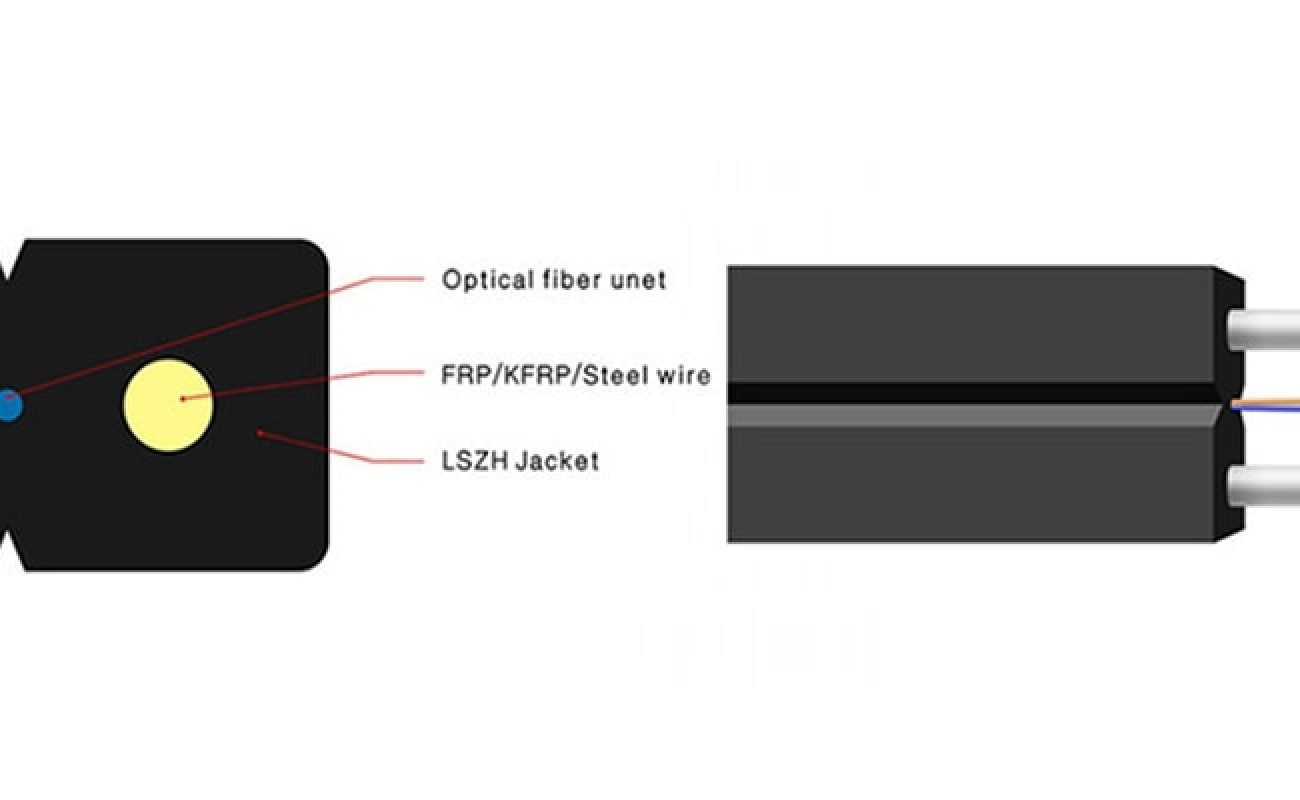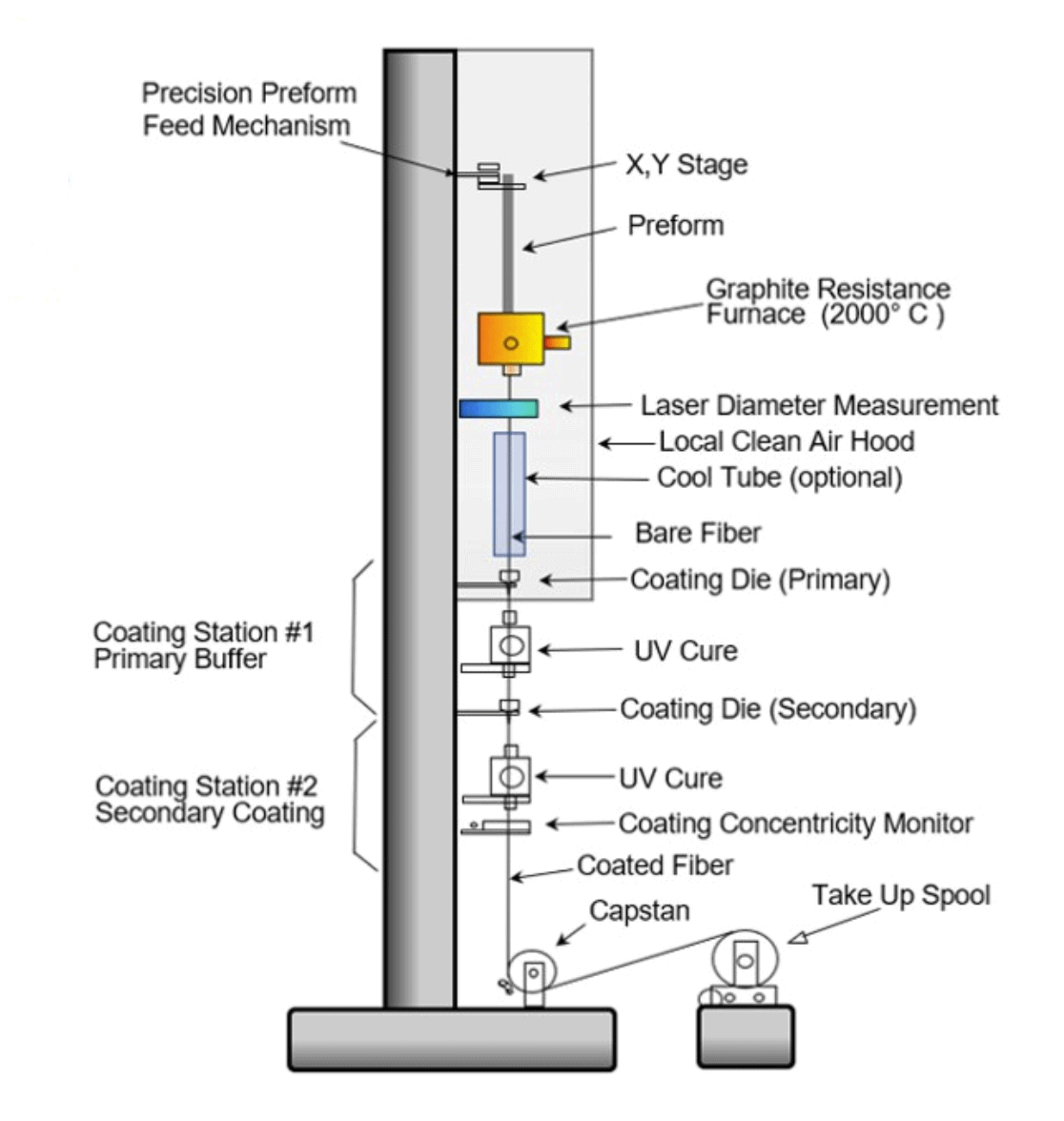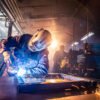What’s FTTH Drop Cable?
Fro the structure below, It can be visually seen that its structure consists of these parts:
- Fiber
- FRP/Steel wire
- Member( steel wire rope )
- LSZH sheath
So if we analyze it according to our previous write-ups: How to Choose a Production Line According to the Different Optic Cable, It is done by the following machines:
- Drawing Tower
- HK-50 IPC+PLC Control FTTH drop cable Production line
How to make the FTTH drop cable by machines?
Drawing Tower
The core and cladding of the optical fiber are made of highly purified silica glass. Optical fibers are made from silica in one of two ways. The first method is the crucible method. In this method, the silicon powder is melted to produce a fatter multimode fiber, which is suitable for the short-distance transmission of many light wave signals. The second method, vapor deposition, produces a solid cylinder composed of a core material and a cladding material, which is then heated and drawn into a thinner single-mode optical fiber for long-distance communication.
Specification of Drawing Tower
- Preform-feed module
- Furnace
- Start-up tractor assembly
- Gas supply system (for argon)
- HEPA filters
- Fiber diameter measurement
- Fiber coating system
- UV and thermal curing ovens
- Coating diameter measurement
- Fiber centering control
- Fiber coating concentricity control
- Fiber tension measurement
- Capstan / fiber puller
- Fiber winder/drum changer
- Fiber proof tester/ rewinder
1. Preform feed module: The preforms are put into a furnace. The speed and placement of the preforms are controlled so that they are in the middle of the furnace. The speed at which the preforms go down into the furnace is set by how fast the wire is being drawn, the size of the preform, and how thin you want the fiber to be.
The fiber diameter is adjusted by how fast the wire is being drawn. The stretching tension is controlled by how hot the furnace is. This tension needs to be monitored and kept constant during drawing so that fibers are not pulled too tight or too loose.
2. Furnace: The preform is put into a hole on the top of the furnace. The furnace is cylindrical and has a vertical axis. There is a hole on the bottom surface from which small diameter fibers come out. Both holes have irises to change the diameter, allowing the operator to control the gas flow in the furnace.
The furnace uses a high-voltage electrical element-usually a graphite resistance unit. In order to start the wire drawing, the preform is put into the furnace. The drawing zone is heated to above 1900°C, where the glass softens and stretches, and water droplets pull down fibers.
3. Start-up tractor assembly: The water that drips below the furnace is cut. The fiber then goes through a two-wheel tractor that pulls it down. The diameter of the fiber is reduced until it reaches the correct specification.
Then the fibers go into a coating system and follow a tower to the bottom. There, a winch takes over and pulls them down. After that, the winch at the bottom controls how fast the fibers are drafted based on a feedback loop with a diameter gauge.
4. Gas supply for the furnace: The furnace is very hot, around 2000°C. But if the temperature gets too high, over 600 to 800°C, graphite will start to break down and create pollution.
To avoid this, argon is used to help control the temperature. Argon also helps stop turbulence in the air that can cause damage. As argon flows through the furnace, we use an iris to control how much comes in and out. It’s important to keep the flow of argon exactly right, so we use different techniques to do that.
5. Air filtration: The slow drafting speed used for specialty fibers means that uncoated fibers are usually cooled by air before coating. Larger telecommunications fiber factories have enclosed sections where the gas is cooled.
Some companies also set up drafting towers in clean rooms. However, most specialty fiber manufacturers use clean ambient air–cleaned with HEPA filters installed behind the preforms and furnaces, and in parts of the tower.
6. Fiber diameter measurement: The diameter of specialty fibers ranges from 50 microns to 1,000 microns (1 mm). Widely used sizes include 80, 125 and 400 µm. The diameter is determined by the drawing speed. Small changes in furnace or preform temperature, inert gas flow, or other drafting conditions can cause small fluctuations in fiber diameter.
To avoid this situation, the tower has a continuously measuring system that sends data to the diameter control loop. The traction speed of the auger can be adjusted using this information. In some cases, there may be a secondary control loop to adjust the preform feed. These control loops use diameter measurements to make quick adjustments.
7. Coating system: Fiber coating is necessary to protect glass fibers and keep them strong. There are also some special fibers that need a coating to help improve their optical performance. Most coatings have two layers: a softer inner layer and a harder outer layer that is attached to the glass.
This means that the coating system must apply and cure two separate resins. The fiber enters the first mold or “cup” of the coating system, which applies the primary coating (inner layer). Some secondary coatings, called “humidification on wet”, can be applied before the primary coating is cured.
8. Concentricity measurement: The diameter of the fiber and its concentricity must be measured using laser-based instruments. The force of the coating material helps keep the fiber in the middle of the mold.
If there is a problem with the concentricity, then the process may need to be stopped and started again. It is important to have a correct coating on the fiber to avoid micro bending losses, which can cause attenuation problems.
9. Capstan and take up reels: The winch on the bottom of the preform pulls the fibers from the end of it. There is also a system that winds the fiber onto a storage reel. The tension on the fiber is controlled to make sure it is wound correctly onto the take-up shaft.
10. Proof tester and rewinder: The tensile strength is a key measurement for finished fibers. Factories use this measurement to find problems with the preform and drafting process. The inspection machine has a pay-off reel, two controllable winches, and a take-up reel.
The proofer is usually near the main winch of the traction tower or in a separate room. Some specialty fiber manufacturers also have rewinding systems to divide the output of the preform into multiple rolls-for the length specified by the fiber customer.
11. Other draw tower equipment: Some types of fibers need different systems to control their specific qualities. For example, circularly polarized fibers and some other types of fibers need to be rotated or twisted during the drawing process.
This can be done by the spinner in the preform chuck or the twisting or shaking device underneath. Drawing photonic crystal fibers with air gaps, voids, and other features may require additional gas flow and gas pressure systems to control internal pressure and humidity.
HK-50 IPC+PLC control FTTH Drop Cable Production Line

- Steel wire rope pay off: put on the1.0-1.2mm steel wire rope as Member( steel wire rope ) mentioned in the structure.
- Straightening Platform: Make the wire straight before entering the cross head
- Fiber pay off: put on 25km/50km bare fiber.
- Control Platform : control all the thing( fiber, steel wire& steel wire rope) before the extruder.
- Main extruder: using the best quality screw from China, extrusion the LSZH/PVC material; the motor using Siemens plus an encoder and adopts closed-loop control to make the production line for diameter change is more stable during the line speed increase or decrease.
- Control cabinet: PLC+IPC control, more easy operation for the worker, the transducer using American Emerson/Mitsubishi, Japanese, other electric parts using Schneider.
- Warm water tank: Connect the sink to automatically replenish warm water trough.
- Cooling water trough: water temperature around 10-25 degree celsius to Cooling stable outer diameter.
- Cooling water tank: Linkage with the Chiller machine, filling the cooling water to the cooling water trough automatic
- OD Gauge: display the actual diameter of the cable to the operator.
- Capstan: automatic change the line speed by Panasonic servo plus Gearbox.
- Double-AxisTake up: motor using Siemens, traversing by servo and there also have a display screen for the operator speed up/down.
Below is the video link of HK-50 IPC+PLC Control FTTH drop cable Production line
Final world
if you are interested in this project, let’s contact us to get the offer












